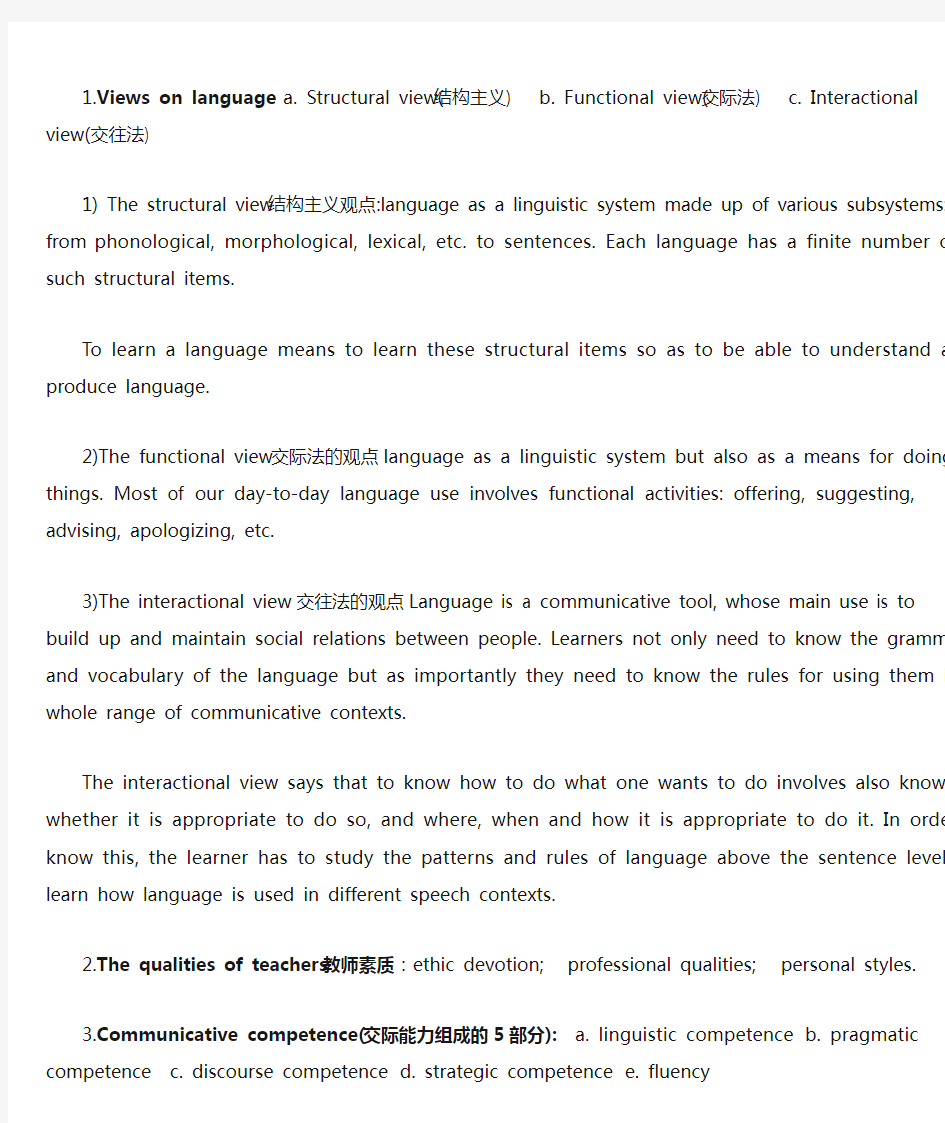
英语教学法复习重点
- 格式:doc
- 大小:70.00 KB
- 文档页数:5


1.Views on language: a. Structural view(结构主义) b. Functional view(交际法) c. Interactional view(交往法)
1) The structural view结构主义观点:language as a linguistic system made up of various subsystems: from phonological, morphological, lexical, etc. to sentences. Each language has a finite number of such structural items.
To learn a language means to learn these structural items so as to be able to understand and produce language.
2)The functional view交际法的观点language as a linguistic system but also as a means for doing things. Most of our day-to-day language use involves functional activities: offering, suggesting, advising, apologizing, etc.
3)The interactional view交往法的观点Language is a communicative tool, whose main use is to build up and maintain social relations between people. Learners not only need to know the grammar and vocabulary of the language but as importantly they need to know the rules for using them in a whole range of communicative contexts.
The interactional view says that to know how to do what one wants to do involves also knowing whether it is appropriate to do so, and where, when and how it is appropriate to do it. In order to know this, the learner has to study the patterns and rules of language above the sentence level to learn how language is used in different speech contexts.
2.The qualities of teachers教师素质:ethic devotion; professional qualities; personal styles.
municative competence(交际能力组成的5部分): a. linguistic competence b. pragmatic competence c. discourse competence d. strategic competence e. fluency
4. Principles of communicative language teaching: a. communication principle b. task principle c. meaningfulness principle
5.classification of communicative activities(交际活动的分类): a. functional communicative activities b. social interaction activities
6.The role of teacher 教师的角色:a. controller b. assessor c. organizer d. prompter e. participant f. resource-provider 7. Classroom instructions: Classroom instructions refer to the type of language teachers use to organize or guide learning. They include giving directions to tasks or activities, providing explanations to a concept or language structure, setting requirements, checking comprehension, drawing attention, motivating learners, giving feedback, and assigning homework, etc.
8. students grouping: a. whole class work b. pair work c. group work d. individual study
6\7\8
1.Three ways to show the stress pattern words, phrases and sentences:1)Use gesture;2)Use the voice;3)Use the blackboard.
2.Factors contribute to successful practice:1) pre-learning 2) volume and repetition 3) success-orientation 4) heterogeneity 5) teacher assistance 6) interest
3.Grammar practice is usually divided into 2 categories: mechanical practice & meaningful/communicative practice.
4.Mechanical practice involves activities that aimed at form accuracy.
5.What does it mean to know a word? Knowing a word mans 1) knowing its pronunciation and stress; 2) knowing its spelling & grammatical properties; 3) knowing its meaning; 4) knowing how & when to use it to express the intended meaning.
9\10\11
1. Principles for teaching listening 1).focus on process.2).combine listening with other skills.3).focus on the comprehension of meaning.4).grade difficulty level appropriately.
2. Factors that affect the difficulty level of listening tasks, but they fall into 3 main categories:1)type of language used.2)task or purpose in listening.3)context in which the listening occurs.
3. Models for teaching reading:1)Bottom-up model.(2)Top-down model 3)Interactive model
4.The characteristic are common in successful speaking tasks:1) Maximum foreign talk; 2)Even participation;3)High motivation;4)Right language level.
5. Littlewood divides communicative speaking activities into 2 types: Communicative activities: functional communication activities and social interaction activities. It also includes Pre-communicative activities: structural activities and
Quasi-communicative activities. Pre-communicative activities are intended to prepare learners for Communicative activities. 6. Pre-reading activities: predicting; setting the scene; skimming; scanning. Skimming means reading quickly to get the gist,e.g.the main idea of the text. Scanning which means to read to locate specific information.
7.Some speaking activities:1)controlled activities: mainly focus on form and accuracy; 2)semi-controlled activities: focus on meaning and communication; 3)communicative activities.
8. Ur points out that factors that affect the success of role-plays are: 1)the teacher’s enthusiasm;2)careful instructions;3)clear situations and roles; 4)and making sure that the students have the language they will need to carry out the role-play.
1.The main procedures of process writing(过程写作)include: Creating a motivation to write; brainstorming; mapping; freewriting; outlining; drafting; editing; revising; proofreading and conferencing.